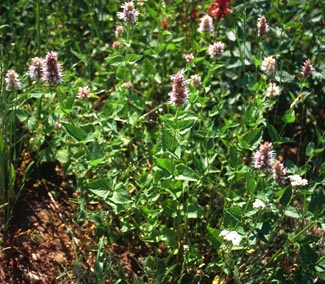Horsemint

Common Name(s):
Horsemint
Nettleleaf Giant Hyssop
Scientific Name:
Agastache urticifolia (Benth.) Kuntze
Scientific Name Synonyms:
None Known
Symbol:
AGUR
Description:
Life Span: Perennial
Origin: Native
Growth Characteristics: Horsemint grows up to 5 feet tall in shade, up to about 1 foot tall in the sun. It flowers in the summer, seeds ripen in September.
Flowers/Inflorescence: Pale blue flowers with a delicate fragrance. Inflorescence is a whorled cluster of white, rose, or violet flowers, up to 8 inches long.
Fruits/Seeds: A nutlet.
Leaves: Leaves up to 5 inches long, oval to triangular, glabrous above, glabrous to pubescent below. They look similar to those of stinging nettle. Leaves are opposite each other on the stem.
Stems: Square stems with leaves.
Roots: Creeping rhizomes
Ecological Adaptions:
Horsemint prefers moist soils on open hillsides, in canyons and mountain valleys, from 6,000-10,000 feet in elevation. It is often found along streambanks. Horsemint is not drought tolerant.
Soils: Sandy or loamy soils, well-drained.
Associated Species: Sagebrush, aspen, ponderosa pine.
Uses and Management:
The leaves are analgesic and antirheumatic. A decoction is taken internally in the treatment of rheumatism, measles, stomach pains and colds. Externally, a poultice of the mashed leaves is applied to swellings.
Seeds cam be eaten raw or cooked.
Lewis and Clark did not collect this plant, but they did use it medicinally while at their camp on the Clearwater River to treat a soldier with chronic, sever backpain.

